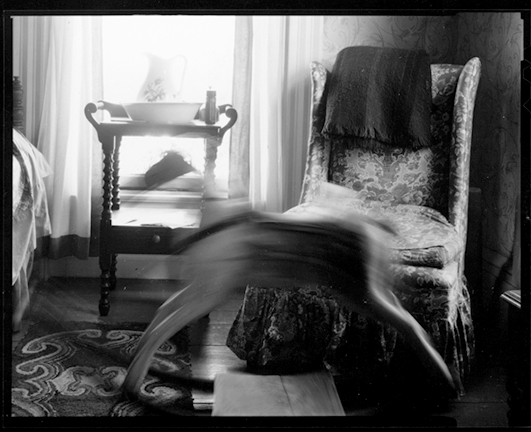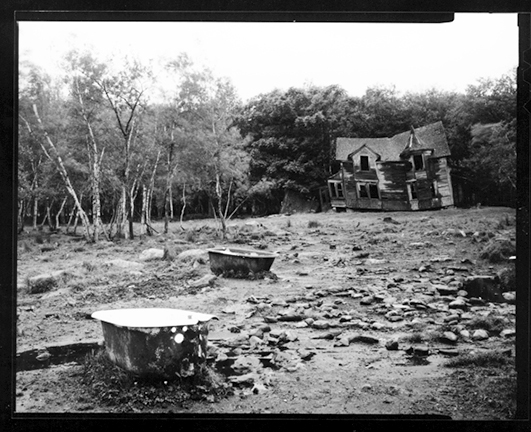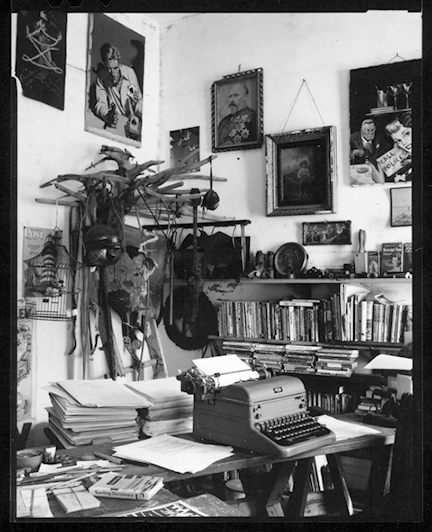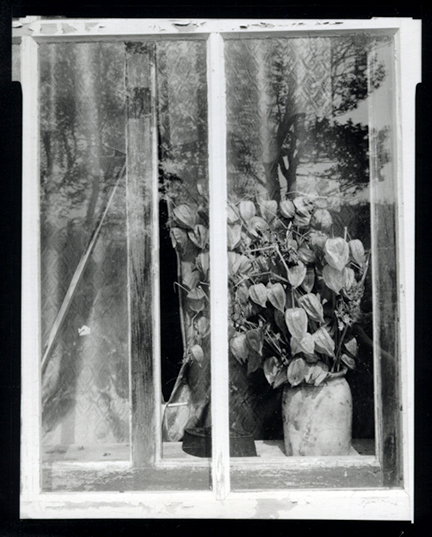Image above: Carlotta Luke by Francie Randolph.
Musée: When did you begin pursuing photography? What sparked your interest in the medium?
Carlotta Luke: I took a photography class in junior year of high school. I had an inspiring teacher and I fell in love with the medium. I soon found myself spending all my spare time in the darkroom. I loved the whole process, the shooting and the magic of printing black and white. I hated having anyone else do my developing and printing so whenever possible, I would set up a makeshift darkroom in the bathroom of wherever I was living. These temporary darkrooms were rarely ideal but they did the job.
M: Your photographic work covers a very broad range, what is your favorite subject to shoot?
C: That is a difficult question. I take so much pleasure in being able to shoot a wide range of subject matter. I think I would get bored if I focused on just one. I love working on long-term projects like the architectural work, watching the spaces and details change over time, seeing how the light varies from season to season. I also love shooting work environments, photographing people engrossed in what they do, their workspaces, tools and machinery. I like being the observer. I try to fade into the background so that people don’t notice me and feel self-conscious.

©Carlotta Luke
M: How did your work as a graphic designer and art director refine your photographic skills?
C: I was very lucky to get a job working for a publisher shortly after I moved to London. Insight Guides was a travel guide publisher lead by an inspirational editor, Brian Bell. Along with an emphasis on high quality writing was a focus on using superb photography. We were known for producing guides with beautiful full page and double page spreads of some of the best travel photography. But these were not coffee table books. They were practical, informative and entertaining. Over the 10 years that I worked with Insight Guides I designed hundreds of books and looked through thousands of photographs. I got very good at analyzing photographs and editing quickly, a skill that has proven useful in my own photographic work.
M: You grew up in New England but are now located in Lewes, England. What made you decide to move across the pond? Did you initially experience any culture shock?
C: I was living out on the tip of Cape Cod when I met my husband Chris, who is English. I was working for the local Provincetown newspaper at the time, but there wasn’t really enough work. Everything would go dead in the winter and jobs would get scaled back. I was interested in seeing what life in England would be like so I came back with Chris. Unfortunately, I arrived right at the beginning of the recession of 1990. I found the transition very difficult at first, harder than I thought it would be. Although we have a shared language, there are so many cultural differences that just have to be learned. Even the language is quite different. But I learned to love it here and feel that it is home. I have lived in England for 25 years now. Sometimes I have culture shock when I go back to New England.
M: I see you had been commissioned to photograph HRH Queen Elizabeth on her trip to visit a local brewery. What was that experience like?
C: That was the most stressful job I have ever done – and probably will ever do! Harvey’s Brewery is a famous local landmark in Lewes. It has been around for over 200 years, owned by eight generations of the same family. The Queen was coming for a tour of the brewery and a lunch in a formal tent set up in the brewery yard, attended by 150 local dignitaries. The owner, Hamish Elder, commissioned me to document the event. There were only three of us allowed to photograph: local and national press and myself.
I went the day before the visit to go through the tour with the Queen’s press secretary. She explained how we were expected to dress and to act and where we would stand at each point in the tour. We were to always be ahead of the queen and photograph her as she approached us.
I photographed the enormous preparations for the Royal visit – the washing, cleaning and painting on the part of Harvey’s but the secret service men were swarmed everywhere. The brewery is sited along the river with an open view to the rest of the town. Hundreds of kegs of beer were moved to form a barrier blocking views from the town.
Hamish informed me that this was the most important event to have ever happened to his company in it’s 200 year history, and asked if I thought I would be able to do it. Although I assured him I could, I didn’t sleep a wink that night.
The day itself went well. The Queen wore a bright pink coat with a striking pink and black hat, making her stand out well amongst the black and grey suits. I wondered if it was intentional and it certainly made my job easier. I was struck by how small and fragile she appeared, although she managed the winding stairs and small spaces of the old brewery with surprising agility.
There are so many details that stand out from the day: the Royal Standard that is allowed to be flown only when the Queen is actually on site; the lines of police polishing their motorbikes, preparing for her motorcade; the interior the Royal Bentley with a book, a blue wool blanket and a small bouquet of flowers on the back seat; the huge ruby broach that matched the pink of the Queen’s coat perfectly that I didn’t notice until I was editing the photographs because I was so busy shooting the entire time she was around.
My favorite shot from the day shows the Queen walking ahead of her entourage, captured at a moment when she appears alone, isolated and slightly stooped inside the huge empty space of the brewery outbuilding. Her husband and the head brewer are just visible through a glass door behind her. It has made me think about how lonely her position of privilege might be.
M: You have also been commissioned to artistically document the renovations of an Elizabethan manor house, as well as Victorian workshops in the town of Newhaven. How did you approach these subjects artistically?
C: I was lucky to be given the commission to document the renovation of Glynde Place, a 450-year-old Elizabethan manor house. The owner, Viscount Hampden, was not interested in a straight document of the building works. He gave me free reign of the huge building, asking me to photograph it however I wanted to.
The house was beautiful but also run down and in need of repairs. I would go every week or two and spend an hour walking through the building, and sometimes the grounds as well. The only way that I can describe my approach was that I entered the house with my eyes open to everything. I tried never to plan what I would photograph and to just be attuned to my environment. The building had a special quality of light and of space that I found perpetually fascinating. They were continually changing, with the seasons, with the weather and through the process of the building works. I looked for shapes, colors and textures, for quirks in perspective, for dust, fog and anything else that made the space transparent or opaque, for small details both ordinary and extraordinary.
I began the project before the renovations began. When the builders moved in, I didn’t know at first how I would incorporate the workers into my photographs. Over time, they became as much a part of my work as the building itself.
The Newhaven project involves photographing the renovation of two Victorian workshops. They are part of a regeneration scheme to build a new engineering high school in an economically depressed port town. I have been hired by the local council to photograph the renovation, again as an artistic project not as a straightforward documentary. The resulting photographs are being used to inform local residents about the progress of the school and will be on permanent display when the school opens, helping to retain a sense of the heritage of the place. Although the Newhaven and Glynde projects are different in many ways, my artistic approach has been similar.

©Carlotta Luke
M: What was the greatest challenge working on these subjects that were undergoing constant change?
C: Actually, I don’t find the constant change a challenge because I am documenting exactly that. It is the change that is interesting to me, although sometimes the change might only be a difference in the quality of light on a particular day. Sometimes the challenge is going for a shoot and not finding very much that interests me enough to photograph – that there isn’t enough change!
Another challenge is the fact of working on a building site. I had a lot of freedom of movement at Glynde Place but I had to juggle my shooting with construction work, power tools, huge holes in the floor and various other dangers.
On the Newhaven project, I am much more restricted. I am escorted around the site, making it harder to feel the freedom to shoot what I want and take as much time as I would like. I have to work faster, and there are some restrictions on what I am allowed to photograph. I am able to work within this but I do miss some good shots because of it.
M: Was it difficult to find beauty amidst workmen and construction tools?
C: I was not sure at first how I would photograph the workers at Glynde Place. I initially felt their presence was an intrusion into the beauty of the spaces. But I began to like how they created unexpected movements and shapes.
I have worked extensively photographing work environments and building sites became another work environment for me to document. I have got to know quite a few of the workers on both sites and admire their skill and knowledge. I try to capture a sense of that in my photographs. Photographing the workers has become a very important part of the projects. And actually I find some construction tools really beautiful! Some of my favorite photographs involve the workmen. Photographing them can allow me to show the dynamic, unexpected and surprising elements of a building site.
M: What was it like working with the band Mumford and Sons?
C: It was so fun. This was a PR shot promoting Mumford and Sons’ Gentlemen of the Road festival that was heading to Lewes a month later. The shoot started at Harvey’s Brewery, because it is such a famous Lewes landmark. I had brought along my 16-year-old son as my assistant. He had recently had a very serious accident and I wanted something to cheer him up.
I had to direct the four band members while I photographed them in a kind of staged old-fashioned brewery set-up. I found that part very stressful. There were a lot of people around there was a real buzz as everyone was in awe of such a famous band. The four band members and their manager then needed to get to the next location where I was to take more photos. To get there we needed to walk up through the center of Lewes. This is when it became surreal. My son and I walked and chatted with the band along the 10-minute walk up the High St of Lewes and not one person recognized them. I was annoyed - I wanted at least one person I knew to see me! We then spent the next couple of hours in the beautiful gardens of an old historic building belonging to the Council: my son and I, the band and their manager, and the chief executive of the Council. They were such lovely guys, very down to earth and relaxed. We just had a laugh, really. I took a lot of photographs that day but the band’s management only allowed the release of two shots.

©Carlotta Luke
M: What photographic experience stands out the most to you?
C: Almost 25 years ago I went to photograph the Whitechapel Bell Foundry in East London. Founded in the 1570s, it was a fascinating place steeped in history. Both Big Ben and the Liberty Bell were cast there. I was allowed access to pretty much anywhere in the foundry, which was surprising considering the dangerous nature of the work.
Apart from being an extraordinary experience, it made me realize that my camera was a passport to places that would otherwise have been inaccessible. If I am photographing, I can enter worlds, and people’s lives, in a way that would usually be impossible to me. I tend to be shy but having a camera in my hand gives me a role and a place within any setting. This is particularly the case within the predominantly male world of the building trade (and other physical labor such as the foundry). I love having a window onto such environments and because I have a clear role and demand respect, I can both observe and be a small part of the process.
M: What was the turning point for you in your career as a photographer?
C: I think it must have been getting the Glynde Place commission. That was the first point at which someone was willing to sign a contract and pay me to photograph for them. Because it is a very important building and is well known locally, the prestige and scale of the job helped get me further work, even work that was not architectural in nature.
M: What's upcoming for you? Are you working on any new projects?
C: The Newhaven project still has a few more months to run. After that, I am looking at some similar architectural projects in London and elsewhere. You have to know about interesting building projects and be at the right place at the right time to get these kinds of commissions. They are not easy to find. Apart from that, I never know who is going to be in touch next and what I will be asked to photograph. That is one reason I love this work.

©Carlotta Luke
Check more of Carlotta's work here: http://www.carlottaluke.com

